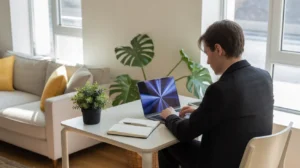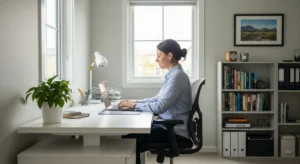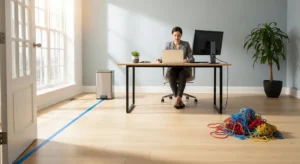
Look around your space. Do you feel a sense of calm, or is there a low hum of static? That static is the friction of clutter. It’s the stack of mail on the counter you have to move to cook, the pile of books on your nightstand you have to shift to find your glasses, the tangle of chargers on your desk that makes it hard to focus. Each small point of disorder is a micro-decision, a tiny drain on your energy and attention. We often believe that achieving an organized life requires a massive, weekend-long purge fueled by sheer willpower. But at The Focused Method, we focus on systems, not sprints. The secret to lasting organization isn’t a one-time heroic effort; it’s a simple, sustainable maintenance habit.
This is where the 10-minute daily tidy up comes in. It’s not about scrubbing floors or reorganizing your entire closet. It’s a small, consistent practice designed to reset your environment, reduce visual noise, and prevent small messes from escalating into overwhelming chaos. This daily habit is the cornerstone of a calmer, more functional home and work life. It’s a system that works with your natural energy levels, creating environmental cues that make tidiness the easy choice, not a monumental task. Instead of fighting against clutter, you’ll be building a gentle, automated current that carries you toward order. In this guide, we’ll break down how to establish this powerful daily tidying habit, create logical zones in your home, and implement simple resets that restore a sense of control and peace in just a few minutes each day. It’s time to trade the friction of clutter for the smooth flow of an organized life.
📚 Table of Contents
- Creating Your Foundation: Zoning, Flow, and the One-Touch Rule
- The Heart of the Habit: Your 10-Minute Daily and Weekly Resets
- Thriving in Reality: Strategies for Small and Shared Spaces
- Putting It Into Practice: Two Mini Makeovers
- Frequently Asked Questions About the Daily Tidy-Up Habit
- How do I even begin a daily habit when I’m buried in a backlog of old clutter, especially paper?
- My family or roommates aren’t on board. How can I implement this without becoming the house cleaner?
- What do I do with sentimental items that don’t have a logical “home” or “zone”?
- My apartment is just too small for any real organization system. What is the single most important thing I can do?
- I’ve tried starting habits like this before, but I can never make them stick. How is this different?
- Your First Steps to a More Organized Life
Creating Your Foundation: Zoning, Flow, and the One-Touch Rule
Before you can effectively tidy up, your belongings need a designated place to go. Without a system of “homes” for your items, a tidy-up session just becomes an exercise in shuffling clutter from one surface to another. The goal is to reduce decision fatigue. When you pick up a stray pair of scissors, you shouldn’t have to ask, “Where should this go?” The answer should be automatic. This is the foundation of a low-maintenance organization system.
The first step is to establish working zones. A zone is simply an area dedicated to a specific activity. Your kitchen might have a coffee zone (mugs, coffee maker, beans), a food prep zone (cutting boards, knives, mixing bowls), and a cleaning zone (sponges, soap, towels). Your home office might have a computer zone, a reference zone for books, and an “inbox” zone for incoming papers. By grouping related items together where they are used, you create an intuitive workflow. You no longer have to cross the room to get a spoon after you’ve poured your coffee. This thoughtful placement reduces physical and mental friction, making tasks smoother and cleanup faster.
This is not about buying dozens of matching containers and a label maker, although you can. A label-light approach often works best. The system should be so logical that it doesn’t require extensive labels. A basket by the door is intuitively for shoes. A charging station on the entryway table is clearly for electronics. The goal is a system that a guest could understand with minimal explanation. The simpler the system, the more likely you and everyone else in your home are to maintain it.
Once your zones are established, you can introduce one of the most powerful habits for maintaining order: the one-touch rule. This principle is simple: whenever you touch an item, you deal with it completely in that one touch. When you bring in the mail, for example, you don’t just drop it on the counter to sort later. You walk it directly to your designated inbox zone, immediately recycling junk mail, shredding sensitive documents, and placing bills or important letters in their designated action folder. This habit single-handedly prevents the buildup of “to-be-dealt-with-later” piles that are the primary source of household clutter.
Finally, think about creating reset points in your main living areas. A reset point is a surface that you commit to keeping clear. This could be your kitchen island, your dining room table, or your coffee table. These surfaces act as visual anchors. Even if the rest of the room is a bit lived-in, a clear central surface creates an immediate and powerful illusion of order and calm. It signals that the space is under control. This clear surface becomes the primary target of your 10-minute daily tidy up. Clearing it provides a significant psychological win and a visual cue that your home is a place of rest, not a collection of pending tasks.
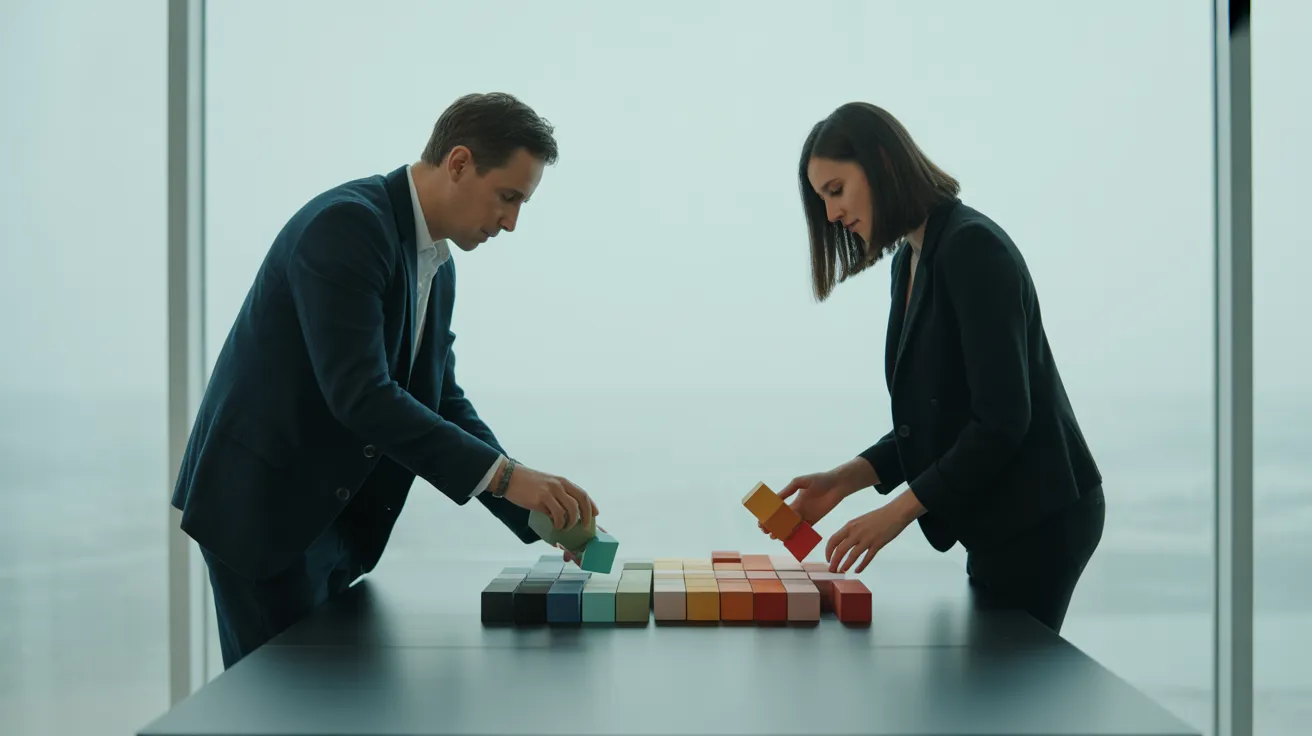
The Heart of the Habit: Your 10-Minute Daily and Weekly Resets
The 10-minute daily tidy up is the engine that drives your entire organization system. It’s a short, focused burst of activity that acts as preventative maintenance for your home. The magic of this routine is its brevity. Anyone can find ten minutes. The low barrier to entry makes it incredibly easy to build into a consistent daily habit. The key is to set a timer and move with purpose, not perfection. You are not deep cleaning; you are simply resetting the space.
So, what does a daily tidy up actually look like? Here’s a simple framework you can adapt to any room:
1. Gather and Relocate (5 minutes): Start in one high-traffic area, like the living room or kitchen. Grab a basket or a reusable shopping bag. Walk through the space and gather everything that doesn’t belong there—mugs, books, shoes, toys, mail. This is your “clutter sweep.” Once your basket is full, quickly walk through your home, depositing each item back in its designated home. Remember those zones you created? This is where they pay off. The coffee mug goes back to the coffee zone, the book goes to the bookshelf, the shoes go in the basket by the door. You’re not organizing drawers; you’re just putting things back where they live.
2. Surface Reset (3 minutes): With the clutter gone, focus on your main reset point. For the living room, this might be the coffee table. For the kitchen, the island. Quickly wipe it down. Fluff the couch cushions. Straighten the stack of magazines. A clear, clean surface instantly makes the entire room feel more put-together. This step provides the biggest visual and psychological reward for your effort.
3. Floor Scan (2 minutes): Do a final quick scan of the floor. Are there any crumbs that need a quick sweep with a hand vacuum? A stray sock to pick up? This final pass ensures the room feels truly reset from top to bottom. When the timer goes off, you stop. Whatever state the room is in, you are done for the day. Consistency is far more important than achieving a perfect result each time.
While the daily tidy up maintains general order, some areas require a slightly more focused weekly reset. Your desk, for instance, is a magnet for clutter. Once a week, perhaps on a Friday afternoon, take 10-15 minutes to reset your workspace. Apply the one-touch rule to your physical inbox, processing every piece of paper. File what needs to be kept, pay what needs to be paid, and shred the rest. A great resource for those interested in professional organizing principles is the National Association of Productivity and Organizing Professionals (NAPO), which offers insights into managing paper and digital clutter effectively.
The same principle applies to your digital life. Your computer desktop can become as cluttered as a physical countertop. Schedule a weekly 5-minute digital declutter. Drag all loose files from your desktop into a single “To Sort” folder. Empty your downloads folder into this same spot. Then, take another few minutes to sort the contents of that folder into your main digital filing system. Just like a clear physical desk, a clear digital desktop reduces visual friction—the mental distraction and low-grade stress caused by a cluttered field of vision. This simple weekly habit keeps your digital workspace as calm and functional as your physical one.

Thriving in Reality: Strategies for Small and Shared Spaces
The principles of organization are universal, but their application needs to be adapted to the realities of your living situation. Grand systems that require dedicated rooms or sprawling storage closets are not practical for those living in small apartments or with roommates and family. The key in these situations is to be strategic, creative, and clear with communication. A daily tidying habit becomes even more critical when space is at a premium, as clutter can take over a small room with astonishing speed.
For those in small apartments or homes, the most valuable real estate is vertical. When you can’t build out, you must build up. Use tall, narrow bookshelves to maximize storage without sacrificing floor space. Install floating shelves above your desk or in the kitchen to get items off your countertops. Over-the-door organizers are brilliant for everything from shoes and accessories in the bedroom to cleaning supplies in a pantry or bathroom. Multi-functional furniture is your best friend. An ottoman with hidden storage, a coffee table that lifts to become a desk, or a bed with built-in drawers can dramatically increase your storage capacity. The goal is to make every square inch work for you.
Living in a shared space presents a different set of challenges. You can’t control other people’s habits, but you can control your own systems and establish clear, respectful boundaries. The most effective strategy is to focus on common areas. Propose a shared 10-minute daily tidy up for the living room or kitchen. Frame it not as a chore, but as a quick “closing duty” for the day that everyone does together, perhaps while listening to a podcast or music. Making it a collaborative, time-boxed activity removes the pressure and prevents one person from feeling like the designated cleaner.
Designating personal zones within shared spaces is also crucial. A simple cube storage unit in the living room can provide each person with their own “cubby” for their personal items—laptops, books, headphones. This prevents personal belongings from colonizing the coffee table. In the bathroom, a shower caddy or a dedicated shelf for each person keeps surfaces clear. The system should be visually obvious and easy to use. The easier you make it for everyone to put their things away, the more likely it is to happen.
Finally, you don’t need to spend a fortune on organizing products. Many effective storage solutions are low-cost or even free. Repurpose sturdy shoeboxes or shipping boxes by covering them in attractive paper or fabric to use as drawer dividers or shelf organizers. Glass jars from pasta sauce or pickles are perfect for storing dry goods in the pantry or pens on a desk. Look for simple, modular solutions that can adapt as your needs change. A set of simple tension rods can be used under a sink to hang spray bottles, instantly doubling your usable space. Some of the most elegant and functional storage solutions can be found at accessible retailers like IKEA, which specialize in designing for small-space living. The focus should always be on function and creating systems that support your daily habits, not on acquiring expensive and complicated products.

Putting It Into Practice: Two Mini Makeovers
Concepts like “zones” and “reset points” can feel abstract. Let’s bring them to life with two common scenarios: the chaotic home office desk and the cluttered kitchen command center. These are narrative examples of how applying the principles of the daily tidy up can transform a space from a source of stress to a pillar of support.
Mini Makeover 1: The Home Office Desk
Imagine a desk piled high with papers, old coffee mugs, and a nest of tangled cables. It’s a classic case of visual friction, making it difficult to even start working. The first step in its transformation wasn’t a massive purge, but a simple zoning exercise. The left side of the desk was designated the “analog zone.” A simple vertical file holder became the inbox for all new papers, and a small tray was set up for a notepad and favorite pens. The center became the “digital zone,” containing only the monitor, keyboard, and mouse. A simple cable management sleeve was used to bundle all the wires into one neat tube. The right side became the “utility zone,” home to a small lamp and a charging station for a phone and headphones. This immediately created a sense of purpose and order.
The new system was then locked in with a two-minute end-of-day reset, a micro-version of the 10-minute tidy. Before shutting down the computer, the routine was to process the inbox using the one-touch rule: file, shred, or schedule any papers that had landed there. The notepad was closed, pens were returned to their tray, and the mug was taken to the kitchen. This tiny habit, taking less time than it takes to brew a cup of tea, ensured the desk was a clean slate every single morning. The overwhelming chaos was replaced by a calm, inviting workspace, ready for focused work without any preliminary clutter-clearing.
Mini Makeover 2: The Kitchen Command Center
Next, consider the classic kitchen counter “drop zone.” It’s the magnetic spot for keys, mail, sunglasses, loose change, and half-read flyers. It’s functional in theory but quickly becomes an eyesore and a source of lost items. The goal was to create a true “command center” that served the same purpose but with structure and intention. The solution was a single, large tray placed on the counter. This tray became the entire command center. Its boundaries were non-negotiable; if an item didn’t fit in the tray, it didn’t belong on the counter.
Within the tray, simple dividers created mini-zones. A small ceramic bowl became the designated home for keys and coins. A slim mail sorter was added to separate incoming mail from outgoing. A small, decorative box held sunglasses and charging cords. The entire counter surface around this tray was declared a reset point. The daily tidy up for the kitchen now included a 30-second check of this command center. Keys were dropped in their bowl, mail was slotted into the sorter, and any other stray items were put away. The tray itself contained the necessary “clutter,” but in an organized, intentional way. The surrounding clear counter restored a sense of spaciousness and order to the entire kitchen, proving that you don’t need to eliminate drop zones entirely—you just need to give them clear and manageable boundaries.

Frequently Asked Questions About the Daily Tidy-Up Habit
Starting a new habit, even one as simple as a 10-minute tidy up, can bring up questions and challenges. Here are answers to some of the most common hurdles people face when trying to build a more organized life.
How do I even begin a daily habit when I’m buried in a backlog of old clutter, especially paper?
This is a very common feeling of being overwhelmed. The key is to separate the backlog project from the daily maintenance habit. Don’t try to conquer a mountain of old paper during your 10-minute tidy. Instead, treat the backlog as a separate, temporary project. Dedicate 15-20 minutes a day, or a few hours one weekend, solely to working through that pile. Put on some music, set a timer, and just start sorting into three boxes: Keep, Shred/Recycle, and Action. Once the backlog is cleared, your daily tidy up will be what prevents it from ever coming back. You can start the daily habit in a different room while you slowly chip away at the big project elsewhere.
My family or roommates aren’t on board. How can I implement this without becoming the house cleaner?
This is a delicate situation that requires leading by example and focusing on shared benefits. You cannot force others to adopt your habits, but you can influence the environment. Start by consistently applying the 10-minute tidy up to your own personal spaces and to the common areas. When others see the positive, calming effect of a consistently clear coffee table or kitchen counter, they are more likely to become interested. Frame it as a team effort. Say, “Let’s set a timer for 10 minutes and see how fast we can reset the living room together.” Making it a quick, collaborative challenge is more effective than nagging. Also, ensure your systems are incredibly easy to use. A clearly marked basket for shoes by the door is much more likely to be used than a complex system hidden in a closet.
What do I do with sentimental items that don’t have a logical “home” or “zone”?
An organized home is not a minimalist, empty home. It’s a home where everything has a place and is treated with intention. Sentimental items are important, and they deserve a special home. The solution is to create a dedicated zone for them. This could be a “memory box”—a beautiful, designated box where you keep cherished cards, photos, and small keepsakes. For larger items, you might dedicate a specific shelf on a bookcase or the top of a dresser as your display area. The goal is to honor these items by giving them a curated space, rather than letting them float around as clutter. This allows you to enjoy them without having them interfere with the function of your daily living spaces.
My apartment is just too small for any real organization system. What is the single most important thing I can do?
In a very small space, the single most impactful action is to define and fiercely protect one single reset point. Maybe it’s your small kitchen table, your desk, or even just the one clear countertop in your kitchen. This surface is your anchor. Commit to making sure this one spot is completely clear and wiped down by the end of every day. This small act creates a powerful pocket of calm and order. It gives your eyes a place to rest and proves that order is possible, even in a tiny footprint. From there, focus on going vertical. Use wall-mounted shelves, hanging organizers, and anything that draws storage upward to free up precious floor and surface space.
I’ve tried starting habits like this before, but I can never make them stick. How is this different?
The reason the 10-minute tidy up is more “sticky” than other habits is its low barrier to entry and its immediate, visible reward. The key to making it permanent is a technique called “habit stacking.” Link the new habit to an existing one you already do without thinking. For example: “After I finish brushing my teeth at night, I will immediately start my 10-minute tidy up.” Or, “While my morning coffee is brewing, I will reset the kitchen counters.” By piggybacking on an established routine, you don’t have to rely on memory or motivation. The old habit becomes the trigger for the new one, automating the process and weaving it seamlessly into the fabric of your day.
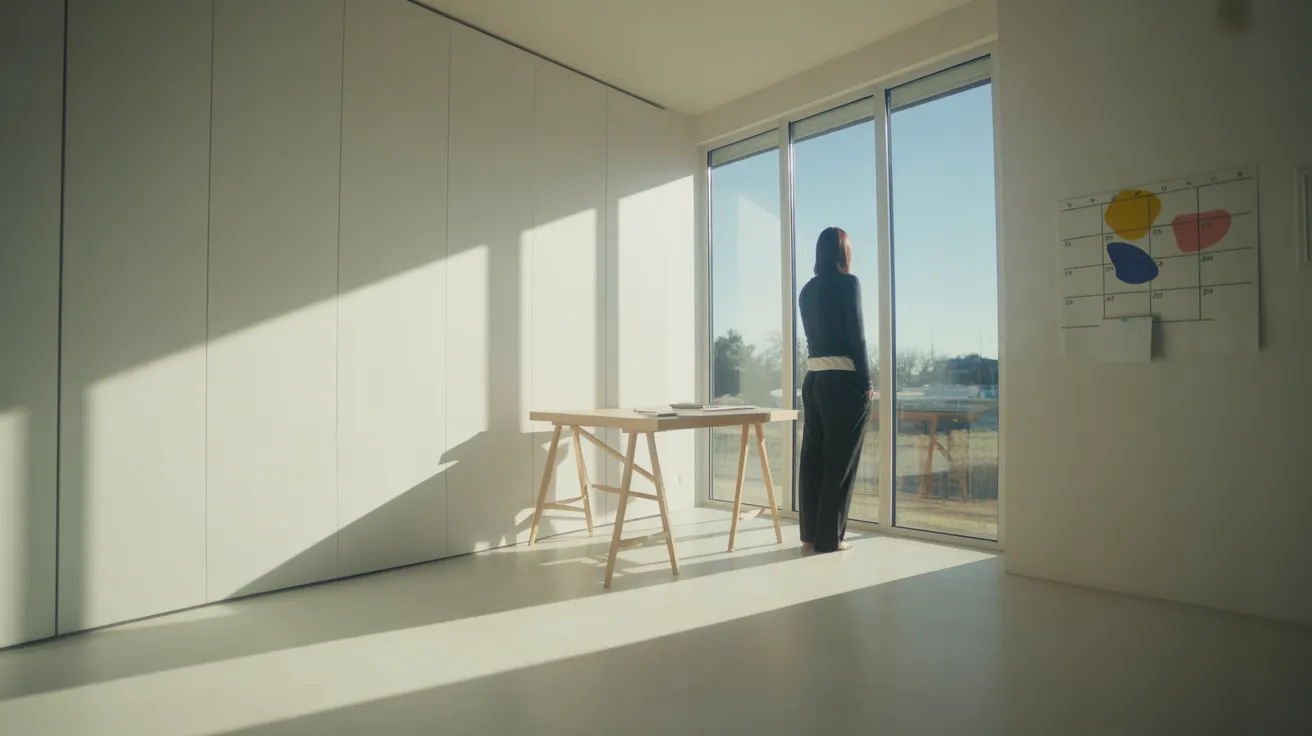
Your First Steps to a More Organized Life
We’ve covered the philosophy, the strategy, and the practical application of the 10-minute daily tidy up. The most important takeaway is that consistency triumphs over intensity every single time. A massive, one-day cleaning marathon might feel productive, but the results are fleeting without a system for maintenance. A simple daily tidying habit is what creates lasting change, transforming your environment from a source of stress into a sanctuary of calm and focus. It’s about building a system that supports you, reducing friction, and making order the path of least resistance.
The journey to an organized life doesn’t start with a trip to a store like The Container Store to buy bins; it starts with a simple decision and a small action. You have the power to reset your space and your mindset, and you can begin this very week. Don’t try to implement everything at once. Choose one or two of these starting points and commit to them for the next seven days.
Here are three simple resets you can start this week to build momentum:
1. Define a Home for Your “Pocket Items.” Tonight, choose a permanent home for the things you carry every day: your keys, wallet, phone, and sunglasses. This could be a small bowl, a tray by the door, or a designated hook. Make a conscious effort to put these items in their new home the moment you walk in the door. This is a mini-exercise in the one-touch rule.
2. Choose Your First “Reset Point.” Select one high-impact surface in your home to be your anchor of calm. This could be your dining table, kitchen island, or coffee table. For the next week, your only goal is to ensure this one surface is completely clear of clutter before you go to bed. Wipe it down. Enjoy the feeling of seeing it clear in the morning.
3. Schedule Your First 10-Minute Tidy. Look at your schedule and decide when your 10-minute tidy will happen. Right after dinner? While your coffee brews? Just before bed? Put it in your calendar. When the time comes, set a timer for just ten minutes, pick one room, and simply put things back where they belong. When the timer dings, you are done. Celebrate the small victory. You are not just cleaning up; you are building the foundation of a calmer, more organized life, one small habit at a time.
Disclaimer: The information provided in this article is for informational purposes only and does not constitute professional, financial, or legal advice. Please consult with a qualified professional for advice tailored to your specific situation.


